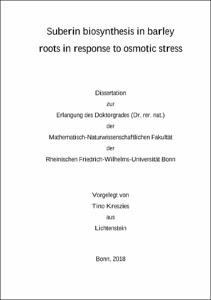Kreszies, Tino: Suberin biosynthesis in barley roots in response to osmotic stress. - Bonn, 2018. - Dissertation, Rheinische Friedrich-Wilhelms-Universität Bonn.
Online-Ausgabe in bonndoc: https://nbn-resolving.org/urn:nbn:de:hbz:5n-52242
Online-Ausgabe in bonndoc: https://nbn-resolving.org/urn:nbn:de:hbz:5n-52242
@phdthesis{handle:20.500.11811/7652,
urn: https://nbn-resolving.org/urn:nbn:de:hbz:5n-52242,
author = {{Tino Kreszies}},
title = {Suberin biosynthesis in barley roots in response to osmotic stress},
school = {Rheinische Friedrich-Wilhelms-Universität Bonn},
year = 2018,
month = oct,
note = {In future climate change will intensify extreme weather conditions, such as drought, which will lead to decreased yields of crops. A decrease in soil water potential is the first signal of potential drought stress for plants. In fact plant roots are the first organs sensing drought and water deficit in soil. At the same time plant roots are the main organ to take up water to supply shoots and leaves. Water uptake in roots is described by the composite transport model. The main components of the model are the apoplastic pathway (cell walls), which can be blocked by Casparian bands and the biopolymer suberin, and the cell-to-cell pathway which can be regulated by aquaporins.
The model plant Arabidopsis and crop plants such as rice and barley have very different root anatomical structures. This explains why a simple transfer of knowledge on root water transport from the model to the crop is not always valid. Especially the correlations between suberin amounts and water uptake require caution.
The response of barley seminal roots to different levels of low water potentials (-0.4, -0.8 and -1.2 MPa) induced by PEG8000 has been studied. In this approach, various experimental methods (histochemistry, analytical chemistry, transcriptomics and transport physiology) were used to test the hypothesis whether an increased suberization of barley roots could represent an efficient response to osmotic stress thus limiting uncontrolled, passive water loss from roots to the dry soil/medium. In response to osmotic stress, genes in the suberin biosynthesis pathway were up-regulated which correlated well with increased suberin amounts in the cell walls of the endodermis and overall reduction of hydraulic conductivity (Lpr). In parallel, transcriptomic data indicated no or only weak effects of water stress on gene expression of aquaporins which are relevant for the cell-to-cell pathway.
Finally, the effect of osmotic stress on seminal roots of wild and cultivated barley was compared. Wild barley has a wider diversity than cultivated barley, which is also represented in the root response to water stress. In contrast to cultivated barley, the suberization of wild barley was delayed and not much affected in response to osmotic stress. Furthermore, Lpr of wild barley was not reduced in response to osmotic stress. Most remarkably, one wild barley accession from Jordan exhibited the formation of a suberized exodermis in about 20% of the seminal roots when exposed to osmotic stress. This was never observed in cultivated barley in all water stress conditions.},
url = {https://hdl.handle.net/20.500.11811/7652}
}
urn: https://nbn-resolving.org/urn:nbn:de:hbz:5n-52242,
author = {{Tino Kreszies}},
title = {Suberin biosynthesis in barley roots in response to osmotic stress},
school = {Rheinische Friedrich-Wilhelms-Universität Bonn},
year = 2018,
month = oct,
note = {In future climate change will intensify extreme weather conditions, such as drought, which will lead to decreased yields of crops. A decrease in soil water potential is the first signal of potential drought stress for plants. In fact plant roots are the first organs sensing drought and water deficit in soil. At the same time plant roots are the main organ to take up water to supply shoots and leaves. Water uptake in roots is described by the composite transport model. The main components of the model are the apoplastic pathway (cell walls), which can be blocked by Casparian bands and the biopolymer suberin, and the cell-to-cell pathway which can be regulated by aquaporins.
The model plant Arabidopsis and crop plants such as rice and barley have very different root anatomical structures. This explains why a simple transfer of knowledge on root water transport from the model to the crop is not always valid. Especially the correlations between suberin amounts and water uptake require caution.
The response of barley seminal roots to different levels of low water potentials (-0.4, -0.8 and -1.2 MPa) induced by PEG8000 has been studied. In this approach, various experimental methods (histochemistry, analytical chemistry, transcriptomics and transport physiology) were used to test the hypothesis whether an increased suberization of barley roots could represent an efficient response to osmotic stress thus limiting uncontrolled, passive water loss from roots to the dry soil/medium. In response to osmotic stress, genes in the suberin biosynthesis pathway were up-regulated which correlated well with increased suberin amounts in the cell walls of the endodermis and overall reduction of hydraulic conductivity (Lpr). In parallel, transcriptomic data indicated no or only weak effects of water stress on gene expression of aquaporins which are relevant for the cell-to-cell pathway.
Finally, the effect of osmotic stress on seminal roots of wild and cultivated barley was compared. Wild barley has a wider diversity than cultivated barley, which is also represented in the root response to water stress. In contrast to cultivated barley, the suberization of wild barley was delayed and not much affected in response to osmotic stress. Furthermore, Lpr of wild barley was not reduced in response to osmotic stress. Most remarkably, one wild barley accession from Jordan exhibited the formation of a suberized exodermis in about 20% of the seminal roots when exposed to osmotic stress. This was never observed in cultivated barley in all water stress conditions.},
url = {https://hdl.handle.net/20.500.11811/7652}
}






